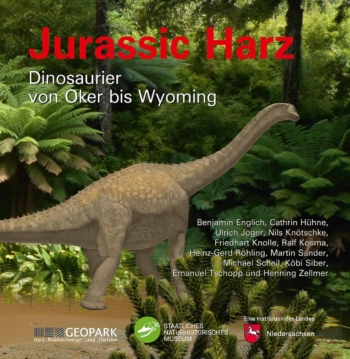The book is aimed at both philatelists and collectors of ammonites and nautilids. It gives a detailed account of all stamps, postmarks and postal stationery known so far. To explain the philatelic material, a short description of the appearance, size and distribution as well as a photograph of the fossil are included. Here it was our endeavour to photographically document the same species if possible, or a closely related species of the same genus if it could not be reached.
Perlboote und Ammonshörner weltweit – Nautilids and Ammonites worldwide
2011. [bilingual: German and English] – 224 pp., 522 figures in color, 4 tables.
24.5 x 21.3 cm, hardcover.
44,80 €
plus shipping costs
Vorwort / Preface 7
Einleitung / Introduction 10
Was ist denn bitte ein Kopffüßer? / What is a cephalopod? 13
Name / Name 13 / 14
Unterschiede zwischen Perlbooten und Ammonshörnern / Differences between nautilids and ammonoids 15
Gehäuseform / Shell shape 15 / 16
Ornament / Ornamentation 16 / 17
Die Wohnkammer / Body Chamber 18
Das Phragmokon / Phragmocone 18 / 19
Die Septen / Septa 19 / 20
Der Sipho und die Regulierung des Auftriebs / The siphuncle and buoyancy regulation 20 / 21
Kieferapparat, Radula und Nahrung / Beak apparatus, radula and diet 23 / 22
Arme und Tentakeln / Arms and tentacles 24 / 23
Augen / Eyes 25 / 24
Entwicklung, Lebensweise und Vermehrung / development, mode of life, and reproduction 25
Dimorphismus / Dimorphism 27
Stabilität / Stability 28
Schwimmen / Swimming 29
Pathologie und Teratologie / Pathology and teratology 30 / 29
Taphonomie / Taphonomy 30
Biostratigraphie / Biostratigraphy 31 / 30
Massenaussterben / Mass extinctions 31 / 31
1. Nautiloidea / Nautiloidea 33
? Endoceras sp. 33
Ophioceras simplex 34
? Lituites sp. 35
Goldringia cyclops 37 / 36
Pseudocenoceras berriasiensis 38
Aturia aturi 39
Unbestimmbare Nautiloidea / Indeterminable Nautiloidea 40
2. Das Perlboot, ein lebendes Fossil / Nautilus – a living fossil 42
Allonautilus scrobiculatus 43
Nautilus macromphalus 45 / 44
Nautilus belauensis 50
Nautilus stenomphalus 55 / 54
Nautilus pompilius 56 / 55
Nautilus sp. 68
Nautilus in der Kunst / Nautilus in art 77
3. Ammonoidea / Ammonoidea 79
3.1 Ammonoidea aus dem Devon / Devonian Ammonoidea 79
Mimosphinctes rudicostatum 79
? Sporadoceras muensteri 80
3.2 Ammonoidea aus dem Karbon / Carboniferous Ammonoidea 81
Merocanites compressus 81
3.3 Ammonoidea aus der Trias / Triassic Ammonoidea 82
Ceratites nodosus 83 / 82
Trachyceras aon 84
Heraclites robustus 85 / 84
? Ticinites polymorphus 86 / 85
Falsanolcites furcosus 87
Choristoceras marshi 88
3.4 Ammonoidea aus dem Jura und der Kreide / Jurassic and Cretaceous Ammonoidea 89
? Phylloceras sp. 89
Hypophylloceras bizonatum 90
Calliphylloceras nillsoni 91
Lytoceras sp. 92
Lytoceras fimbriatum 93 / 92
Gaudryceras denseplicatum 93 / 94
Schlotheimia angulata 95
Arietites sp. 97
Echioceras raricostatum 98
Promicroceras cf. planicosta 100
Uptonia sp. 101
Amaltheus margaritatus 102
Pleuroceras spinatum 103
Catacoeloceras raquinianum 106
Dactylioceras athleticum 107 / 106
Peronoceras fibulatum 111 / 110
Grammoceras thouarsense 111
Hildoceras sublevisoni 113 / 112
Pleydellia aalensis 114 / 113
Pleydellia sp. 115
Pseudomercaticeras bayani 116
Accardia sp. 117
Aconeceras cf. patagonica 118
Hemihaploceras piccininii 119
Taramelliceras ex gr. kobyi 120
Stephanoceras macer 121
Teloceras blagdeni 123 / 122
Kosmoceras phaeinum 124
Kosmoceras sp. 126 / 125
Cardioceras sp. 127 / 126
Parkinsonia parkinsoni 128
Perisphinctes vignalensis 129
Perisphinctes panthieri polonicus 130
cf. Perisphinctes sp. 131 / 130
Dichotomoceras bifurcatoides 132
? Dorsoplanites sp. 133
? Lithacoceras sp. 134
Idoceras sp. 135 / 134
Berbericeras sekikensis 136
Usseliceras franconicum 137
Ernstbrunnia fasciculata 138
Reineckeia crassicostata 140
Reineckeites sp. 141
Peltoceras athleta 142
Clambites hypselus 143 / 142
Pachydesmoceras sp. 144
Lytodiscoides conduciensis 145
Parapuzosia seppenradensis 146
Parapuzosia sp. 147
Gunnarites cf. antarcticus 149
Menuites japonicum 150
? Lewesiceras sp. 151
Schloenbachia sp. 153
Placenticeras cf. meeki 154
Mortoniceras cf. commune 155 / 156
Oxytropidoceras peruvianum multifidum 157
? Acanthoceras sp. 158
Cunningtoniceras cunningtoni 159
Calycoceras haugi 160
Calycoceras sp. 161 / 160
Buchiceras subplanum 163 / 162
Texanites presoutoni presoutoni 163 / 164
Ancyloceras matheronianum 164 / 165
Crioceratites emerici 166 / 165
? Crioceratites sp. 166
Turrilites sp. 167
Douvilleiceras mammilatum 168
Deshaysites deshayesi 169
Hypacanthoplites sp. 171 / 170
Nostoceras helicinium 171
Nostoceras muramatoi 173 / 172
Jouaniceras sp. 173
Polyptychoceras pseudogaultianum 175 / 174
Hysteroceras crassicostatum 175
Ammonoidea gen. et sp. indet. 176
4. Belemnitida / Belemnitida 193
Pachybelemnopsis sp. 193
Acrocoelites sp. 193
Unbestimmbare Belemniten / Indeterminable belemnites 194
Anhang / Appendix 196
Literatur / Literature 197
Philatelie / Philately 197
Paläontologie / Palaeontology 197
Abbildungsnachweis / Index of Illustrations 199
Among the invertebrates, the cephalopod molluscs doubtlessly produced the most intelligent organisms which populate today’s oceans. Both the cognitive performance of trainable octopuses and the perfect mimicry of numerous squids are fascinating; as “chameleons of the oceans” they can turn invisible by adapting their pigmentation to their background within seconds or they imitate coeval predators in order to protect themselves from attackers. Cephalopods also hold a number of world records, which would be worth being mentioned in the book “Guinness world records”; for instance, the legendary giant squids are the largest molluscs on earth and additionally, with a diameter of up to 20 cm, their eyes (which closely resemble vertebrate eyes) are the largest among all animals. As documented by BERNHARD KEGEL’s novel “the red”, the monstrous giant squids from the abyss fire mankind’s imagination since the middle ages up to now. The usually hardly over 20 cm measuring nautiluses which live between the tropical island paradises of the Pacific also hold a world record: they lay eggs with a diameter of more than 2 cm, which thus are, in relation to their body volume, by far the largest eggs among all invertebrates. Modern squids could be record breaking concerning the yield of high grade biomass by mass reproduction in a rapid sequence. Regarding the intense overfishing of the world’s oceans, cephalopods might ensure the survival of significant parts of mankind because their potential as a food source is currently exploited only fractionally. Due to this fact, the research on cephalopod evolution and ecological needs receives increasing significance.
With their chambered shells, external in Nautilus and internal in Sepia-like animals, cephalopods developed the technology of submarines long before mankind; an elaborate system of water-exchange in the basically gas-filled chambers enables these animals to achieve an energy-saving balance of their buoyancy in the water column. This balance can be adjusted to the corresponding diving depth.
Especially the nautilids connect us, as far as some aspects of mode of life and the organism’s form are concerned, with the ammonites because, as “living fossils”, their common ancestors originated already as far back as approximately 500 million years. This is of great interest since ammonites represent the most famous fossil group of the Palaeozoic and the Mesozoic. The aesthetics which emanates from the often opulently adorned spiral shells, especially when preserved with their colourful mother of pearl shell-layer, has stimulated mankind’s imagination around the globe. Both in the old world and in northern America, indigenous people have assigned magic, cultic, ruminant and even fertility-increasing properties to these fossils. The oldest evidence for the attention ammonite fossils received from humans was discovered in the Vogelherd-Höhle near Ulm; these discoveries of ammonite fossils show traces of human processing from the late Palaeolithic. It thus comes to no surprise that such objects have found their way into philately.
Ammonites are captivating because of their inexhaustible variety of shapes, but also because they constructed coiled conchs with a diameter of far over two meters as testified by ammonite specimens from the Cretaceous of the Münsterland in Germany [translator’s note: this has nothing to do with monsters or “the munsters”]. In addition to the tremendous diversity in variably shaped species, the morphological spectrum of ammonites is even increased by the occasionally extreme sexual dimorphism. Shells of male animals often show extreme differences to their female counterparts not only in size but also in the aperture shape and in ornamentation. Ammonoid phylogeny is in many cases documented in almost each single evolutionary step in the stacked sequence of sedimentary rocks. These evolutionary lineages made ammonoids especially attractive study objects already in the 18th century. In the course of their approximately 350 Million yearpredominance in the planet’s oceans, ammonoids experienced several crises during global mass extinctions. Except for the last major mass extinction at the end of the Mesozoic 65 Million years ago, they always managed to survive each of the major crises with one tiny group. Their intermittent evolution still represents a stimulus for the recognition of patterns and mechanisms of biodiversity dynamics, partially because of their rapid post-extinction radiations which repeatedly yielded a plethora of new species. Iterative evolutionary pulses of the ammonoids were also affected by the change from the characteristically predatory mode of life towards a microphagous plankton-feeding mode of life.
The spiral shell is characteristic for modern nautilids as well as most ammonites. Its seemingly perfectly geometric shape epitomises the symbol of the universal principle for meditation purposes in many esoteric philosophies. Both nautilids and ammonites both independently and repeatedly evolved such coiled shells from the straight ones of their ancestors. Its functional driving force is that the soft body attains a horizontal orientation which is advantageous for horizontal swimming by this spiralisation. Their ancestors with straight shells had the gas-filled chambered part at their rear end which forced their soft body in a downward position.
With this book, the two authors complement one another in an optimal way and present an appealing compilation of cephalopod-illustrations on stamps and postmarks. It gives in-depth information on the philatelic background as well as on the anatomicscientific specifics of the illustrated objects. I am convinced that this book will convey the enthusiasm for these fascinating organisms to a new group of people by the indirect occupation with ammonoids via philatelic illustrations, what usually occurs to scientists and fossil-collectors by the direct contact with the actual objects.
Berlin, January 2009
Prof. Dr. HELMUT KEUPP
Freie Universität Berlin
Dr. med. Hans Ulrich ERNST, born in 1949, studied medicine in Cologne and is the head physician of a specialist clinic for orthopaedic rehabilitation. He has been collecting stamps since his school days, among others about "fossils". For some years now he has also been interested in fossils themselves and started to build up a trilobite collection.
Dr. habil. Christian KLUG, born in 1969, studied geology and palaeontology at the University of Tübingen and at Northern Arizona University in Flagstaff. He did his doctorate on Devonian ammonoidea from Morocco. After a scientific traineeship at the State Museum of Natural History in Stuttgart, he took up a position as a research assistant at the Palaeontological Institute and Museum of the University of Zurich, which he still holds today.
You must be logged in to post a review.
"*" indicates required fields
Related products
We’re here for you
Verlag Dr. Friedrich Pfeil
Hauptstraße 12B
5232 Bergkirchen OT Günding – Germany
Tel.: +49 8131 61 46 590
Fax: +49 8131 61 46 591
E-Mail: info@pfeil-verlag.de
Contact
Tel.: +49 89 742827-0
Fax: +49 89 7242772
E-Mail: info@pfeil-verlag.de






Reviews
There are no reviews yet.